Application of eLearning in Manufacturing SMEs: A UK Case Study
VerifiedAdded on 2022/09/01
|7
|1889
|28
Case Study
AI Summary
This case study investigates the successful implementation of eLearning within manufacturing SMEs, specifically focusing on Flood Protection Solutions, a UK-based company. The study highlights the challenges SMEs face in providing adequate training, such as time constraints and cost, and how eLearning offers a viable solution. The case study details how Flood Protection Solutions utilized online courses to enhance employee skills and improve sales strategies, overcoming travel budget limitations and scheduling conflicts. It references academic research and industry publications to explore the benefits of eLearning, including flexibility, affordability, and the ability to revisit lessons. The analysis also considers factors influencing SMEs' training decisions, such as company size and ownership structure, and provides insights into best practices for adopting eLearning to drive business performance and employee development. The study concludes by emphasizing the ongoing need for SMEs to invest in employee training to maintain competitiveness and adapt to market changes.

Provide a case study of how eLearning has been successfully applied to one or two
manufacturing SMEs.
Student's name
Institution Affiliation(s)
manufacturing SMEs.
Student's name
Institution Affiliation(s)
Paraphrase This Document
Need a fresh take? Get an instant paraphrase of this document with our AI Paraphraser
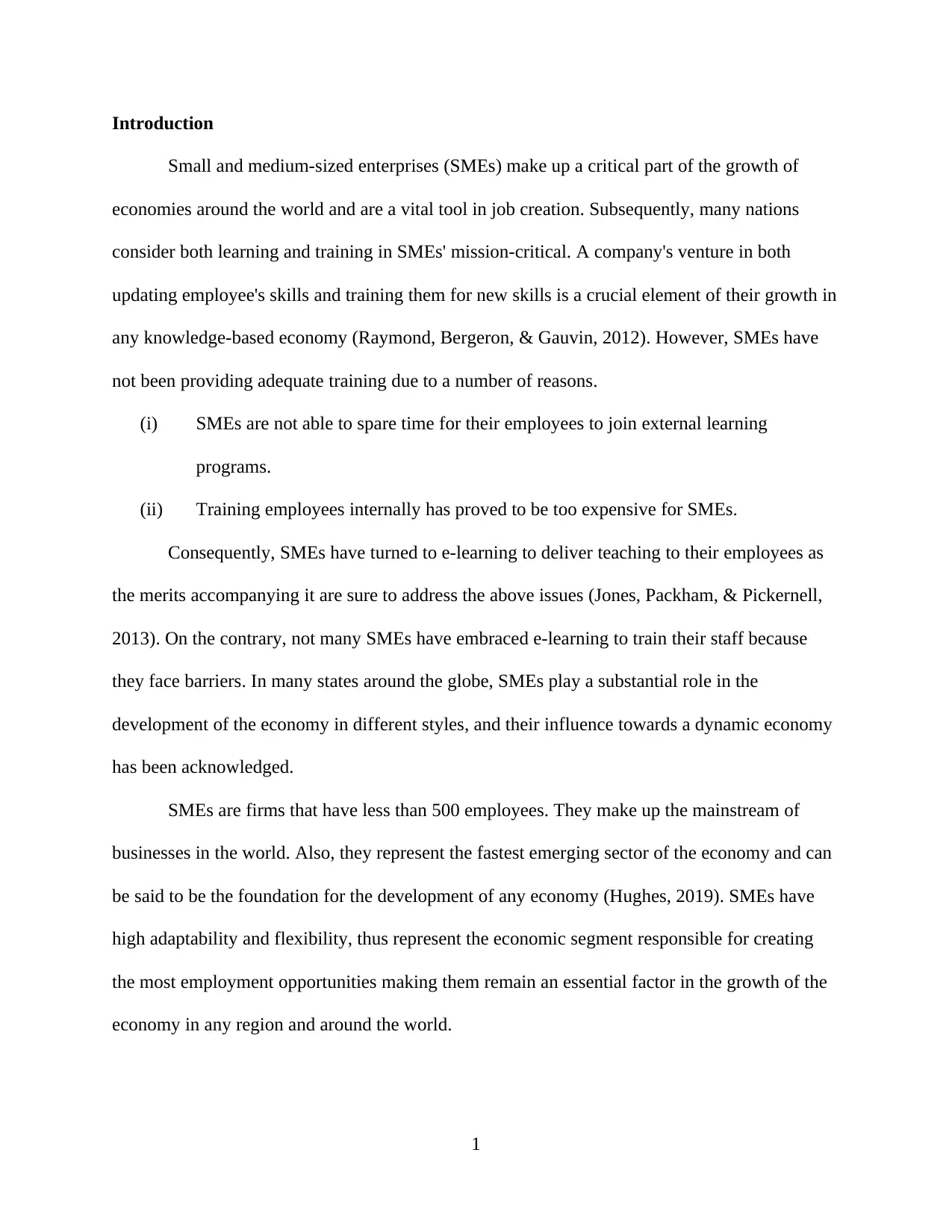
Introduction
Small and medium-sized enterprises (SMEs) make up a critical part of the growth of
economies around the world and are a vital tool in job creation. Subsequently, many nations
consider both learning and training in SMEs' mission-critical. A company's venture in both
updating employee's skills and training them for new skills is a crucial element of their growth in
any knowledge-based economy (Raymond, Bergeron, & Gauvin, 2012). However, SMEs have
not been providing adequate training due to a number of reasons.
(i) SMEs are not able to spare time for their employees to join external learning
programs.
(ii) Training employees internally has proved to be too expensive for SMEs.
Consequently, SMEs have turned to e-learning to deliver teaching to their employees as
the merits accompanying it are sure to address the above issues (Jones, Packham, & Pickernell,
2013). On the contrary, not many SMEs have embraced e-learning to train their staff because
they face barriers. In many states around the globe, SMEs play a substantial role in the
development of the economy in different styles, and their influence towards a dynamic economy
has been acknowledged.
SMEs are firms that have less than 500 employees. They make up the mainstream of
businesses in the world. Also, they represent the fastest emerging sector of the economy and can
be said to be the foundation for the development of any economy (Hughes, 2019). SMEs have
high adaptability and flexibility, thus represent the economic segment responsible for creating
the most employment opportunities making them remain an essential factor in the growth of the
economy in any region and around the world.
1
Small and medium-sized enterprises (SMEs) make up a critical part of the growth of
economies around the world and are a vital tool in job creation. Subsequently, many nations
consider both learning and training in SMEs' mission-critical. A company's venture in both
updating employee's skills and training them for new skills is a crucial element of their growth in
any knowledge-based economy (Raymond, Bergeron, & Gauvin, 2012). However, SMEs have
not been providing adequate training due to a number of reasons.
(i) SMEs are not able to spare time for their employees to join external learning
programs.
(ii) Training employees internally has proved to be too expensive for SMEs.
Consequently, SMEs have turned to e-learning to deliver teaching to their employees as
the merits accompanying it are sure to address the above issues (Jones, Packham, & Pickernell,
2013). On the contrary, not many SMEs have embraced e-learning to train their staff because
they face barriers. In many states around the globe, SMEs play a substantial role in the
development of the economy in different styles, and their influence towards a dynamic economy
has been acknowledged.
SMEs are firms that have less than 500 employees. They make up the mainstream of
businesses in the world. Also, they represent the fastest emerging sector of the economy and can
be said to be the foundation for the development of any economy (Hughes, 2019). SMEs have
high adaptability and flexibility, thus represent the economic segment responsible for creating
the most employment opportunities making them remain an essential factor in the growth of the
economy in any region and around the world.
1
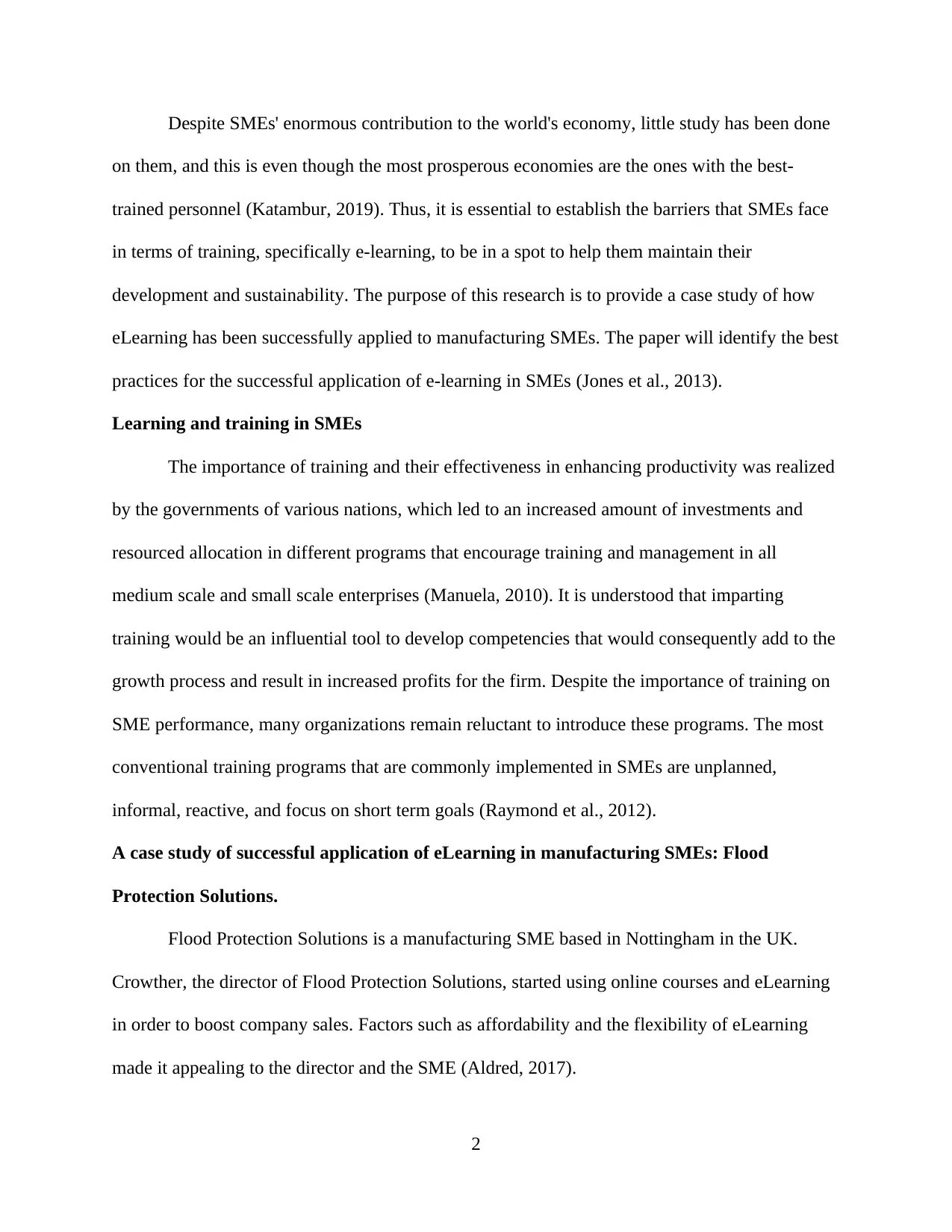
Despite SMEs' enormous contribution to the world's economy, little study has been done
on them, and this is even though the most prosperous economies are the ones with the best-
trained personnel (Katambur, 2019). Thus, it is essential to establish the barriers that SMEs face
in terms of training, specifically e-learning, to be in a spot to help them maintain their
development and sustainability. The purpose of this research is to provide a case study of how
eLearning has been successfully applied to manufacturing SMEs. The paper will identify the best
practices for the successful application of e-learning in SMEs (Jones et al., 2013).
Learning and training in SMEs
The importance of training and their effectiveness in enhancing productivity was realized
by the governments of various nations, which led to an increased amount of investments and
resourced allocation in different programs that encourage training and management in all
medium scale and small scale enterprises (Manuela, 2010). It is understood that imparting
training would be an influential tool to develop competencies that would consequently add to the
growth process and result in increased profits for the firm. Despite the importance of training on
SME performance, many organizations remain reluctant to introduce these programs. The most
conventional training programs that are commonly implemented in SMEs are unplanned,
informal, reactive, and focus on short term goals (Raymond et al., 2012).
A case study of successful application of eLearning in manufacturing SMEs: Flood
Protection Solutions.
Flood Protection Solutions is a manufacturing SME based in Nottingham in the UK.
Crowther, the director of Flood Protection Solutions, started using online courses and eLearning
in order to boost company sales. Factors such as affordability and the flexibility of eLearning
made it appealing to the director and the SME (Aldred, 2017).
2
on them, and this is even though the most prosperous economies are the ones with the best-
trained personnel (Katambur, 2019). Thus, it is essential to establish the barriers that SMEs face
in terms of training, specifically e-learning, to be in a spot to help them maintain their
development and sustainability. The purpose of this research is to provide a case study of how
eLearning has been successfully applied to manufacturing SMEs. The paper will identify the best
practices for the successful application of e-learning in SMEs (Jones et al., 2013).
Learning and training in SMEs
The importance of training and their effectiveness in enhancing productivity was realized
by the governments of various nations, which led to an increased amount of investments and
resourced allocation in different programs that encourage training and management in all
medium scale and small scale enterprises (Manuela, 2010). It is understood that imparting
training would be an influential tool to develop competencies that would consequently add to the
growth process and result in increased profits for the firm. Despite the importance of training on
SME performance, many organizations remain reluctant to introduce these programs. The most
conventional training programs that are commonly implemented in SMEs are unplanned,
informal, reactive, and focus on short term goals (Raymond et al., 2012).
A case study of successful application of eLearning in manufacturing SMEs: Flood
Protection Solutions.
Flood Protection Solutions is a manufacturing SME based in Nottingham in the UK.
Crowther, the director of Flood Protection Solutions, started using online courses and eLearning
in order to boost company sales. Factors such as affordability and the flexibility of eLearning
made it appealing to the director and the SME (Aldred, 2017).
2
⊘ This is a preview!⊘
Do you want full access?
Subscribe today to unlock all pages.

Trusted by 1+ million students worldwide
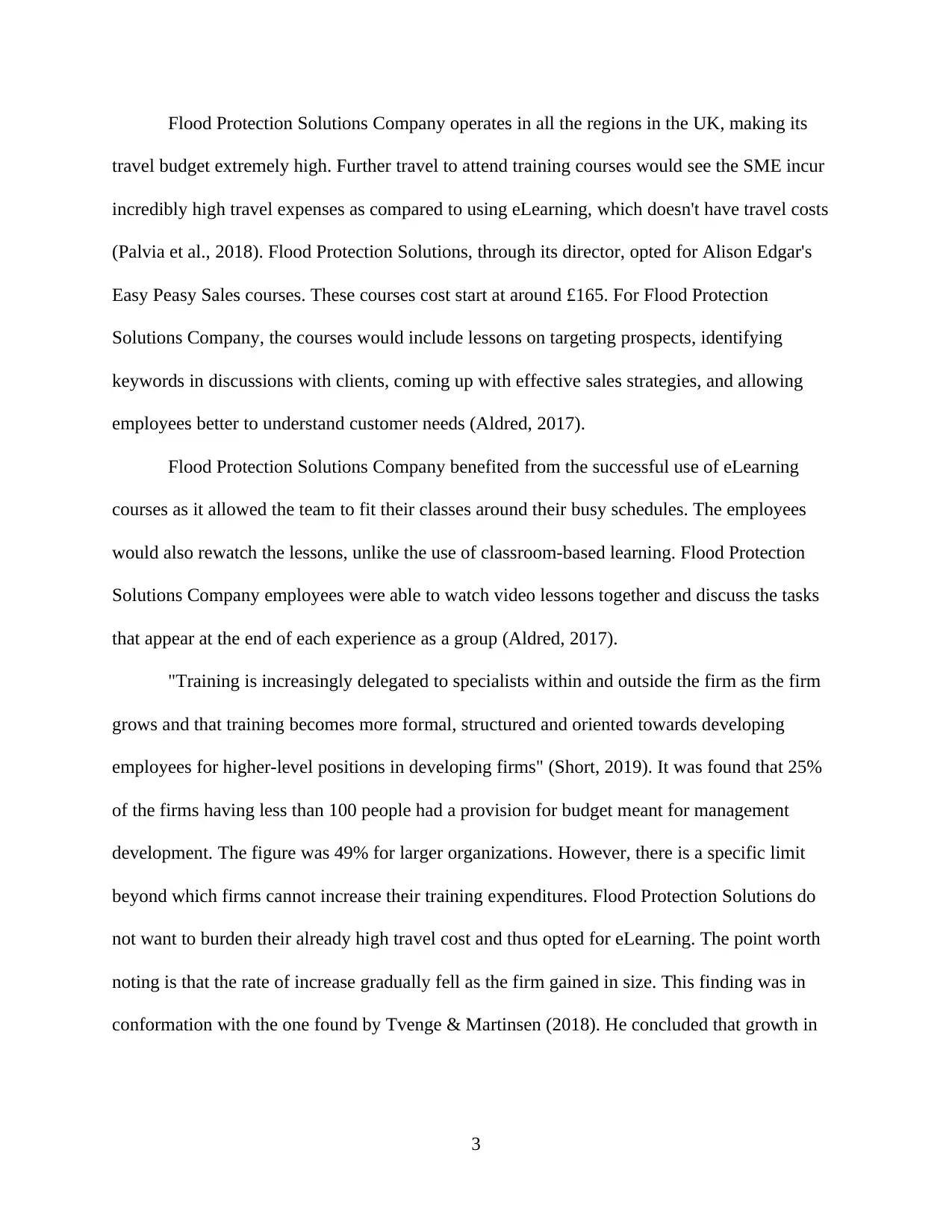
Flood Protection Solutions Company operates in all the regions in the UK, making its
travel budget extremely high. Further travel to attend training courses would see the SME incur
incredibly high travel expenses as compared to using eLearning, which doesn't have travel costs
(Palvia et al., 2018). Flood Protection Solutions, through its director, opted for Alison Edgar's
Easy Peasy Sales courses. These courses cost start at around £165. For Flood Protection
Solutions Company, the courses would include lessons on targeting prospects, identifying
keywords in discussions with clients, coming up with effective sales strategies, and allowing
employees better to understand customer needs (Aldred, 2017).
Flood Protection Solutions Company benefited from the successful use of eLearning
courses as it allowed the team to fit their classes around their busy schedules. The employees
would also rewatch the lessons, unlike the use of classroom-based learning. Flood Protection
Solutions Company employees were able to watch video lessons together and discuss the tasks
that appear at the end of each experience as a group (Aldred, 2017).
"Training is increasingly delegated to specialists within and outside the firm as the firm
grows and that training becomes more formal, structured and oriented towards developing
employees for higher-level positions in developing firms" (Short, 2019). It was found that 25%
of the firms having less than 100 people had a provision for budget meant for management
development. The figure was 49% for larger organizations. However, there is a specific limit
beyond which firms cannot increase their training expenditures. Flood Protection Solutions do
not want to burden their already high travel cost and thus opted for eLearning. The point worth
noting is that the rate of increase gradually fell as the firm gained in size. This finding was in
conformation with the one found by Tvenge & Martinsen (2018). He concluded that growth in
3
travel budget extremely high. Further travel to attend training courses would see the SME incur
incredibly high travel expenses as compared to using eLearning, which doesn't have travel costs
(Palvia et al., 2018). Flood Protection Solutions, through its director, opted for Alison Edgar's
Easy Peasy Sales courses. These courses cost start at around £165. For Flood Protection
Solutions Company, the courses would include lessons on targeting prospects, identifying
keywords in discussions with clients, coming up with effective sales strategies, and allowing
employees better to understand customer needs (Aldred, 2017).
Flood Protection Solutions Company benefited from the successful use of eLearning
courses as it allowed the team to fit their classes around their busy schedules. The employees
would also rewatch the lessons, unlike the use of classroom-based learning. Flood Protection
Solutions Company employees were able to watch video lessons together and discuss the tasks
that appear at the end of each experience as a group (Aldred, 2017).
"Training is increasingly delegated to specialists within and outside the firm as the firm
grows and that training becomes more formal, structured and oriented towards developing
employees for higher-level positions in developing firms" (Short, 2019). It was found that 25%
of the firms having less than 100 people had a provision for budget meant for management
development. The figure was 49% for larger organizations. However, there is a specific limit
beyond which firms cannot increase their training expenditures. Flood Protection Solutions do
not want to burden their already high travel cost and thus opted for eLearning. The point worth
noting is that the rate of increase gradually fell as the firm gained in size. This finding was in
conformation with the one found by Tvenge & Martinsen (2018). He concluded that growth in
3
Paraphrase This Document
Need a fresh take? Get an instant paraphrase of this document with our AI Paraphraser
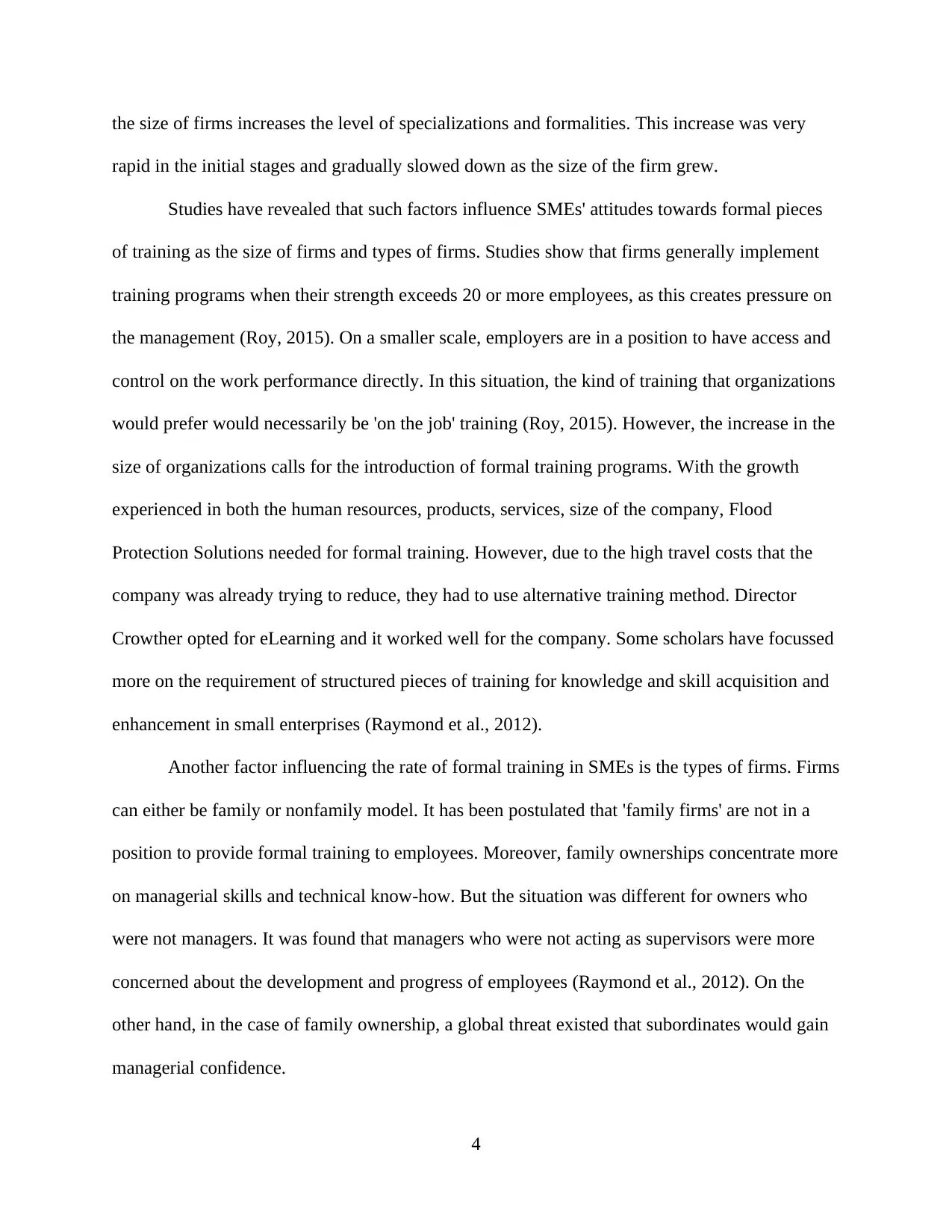
the size of firms increases the level of specializations and formalities. This increase was very
rapid in the initial stages and gradually slowed down as the size of the firm grew.
Studies have revealed that such factors influence SMEs' attitudes towards formal pieces
of training as the size of firms and types of firms. Studies show that firms generally implement
training programs when their strength exceeds 20 or more employees, as this creates pressure on
the management (Roy, 2015). On a smaller scale, employers are in a position to have access and
control on the work performance directly. In this situation, the kind of training that organizations
would prefer would necessarily be 'on the job' training (Roy, 2015). However, the increase in the
size of organizations calls for the introduction of formal training programs. With the growth
experienced in both the human resources, products, services, size of the company, Flood
Protection Solutions needed for formal training. However, due to the high travel costs that the
company was already trying to reduce, they had to use alternative training method. Director
Crowther opted for eLearning and it worked well for the company. Some scholars have focussed
more on the requirement of structured pieces of training for knowledge and skill acquisition and
enhancement in small enterprises (Raymond et al., 2012).
Another factor influencing the rate of formal training in SMEs is the types of firms. Firms
can either be family or nonfamily model. It has been postulated that 'family firms' are not in a
position to provide formal training to employees. Moreover, family ownerships concentrate more
on managerial skills and technical know-how. But the situation was different for owners who
were not managers. It was found that managers who were not acting as supervisors were more
concerned about the development and progress of employees (Raymond et al., 2012). On the
other hand, in the case of family ownership, a global threat existed that subordinates would gain
managerial confidence.
4
rapid in the initial stages and gradually slowed down as the size of the firm grew.
Studies have revealed that such factors influence SMEs' attitudes towards formal pieces
of training as the size of firms and types of firms. Studies show that firms generally implement
training programs when their strength exceeds 20 or more employees, as this creates pressure on
the management (Roy, 2015). On a smaller scale, employers are in a position to have access and
control on the work performance directly. In this situation, the kind of training that organizations
would prefer would necessarily be 'on the job' training (Roy, 2015). However, the increase in the
size of organizations calls for the introduction of formal training programs. With the growth
experienced in both the human resources, products, services, size of the company, Flood
Protection Solutions needed for formal training. However, due to the high travel costs that the
company was already trying to reduce, they had to use alternative training method. Director
Crowther opted for eLearning and it worked well for the company. Some scholars have focussed
more on the requirement of structured pieces of training for knowledge and skill acquisition and
enhancement in small enterprises (Raymond et al., 2012).
Another factor influencing the rate of formal training in SMEs is the types of firms. Firms
can either be family or nonfamily model. It has been postulated that 'family firms' are not in a
position to provide formal training to employees. Moreover, family ownerships concentrate more
on managerial skills and technical know-how. But the situation was different for owners who
were not managers. It was found that managers who were not acting as supervisors were more
concerned about the development and progress of employees (Raymond et al., 2012). On the
other hand, in the case of family ownership, a global threat existed that subordinates would gain
managerial confidence.
4
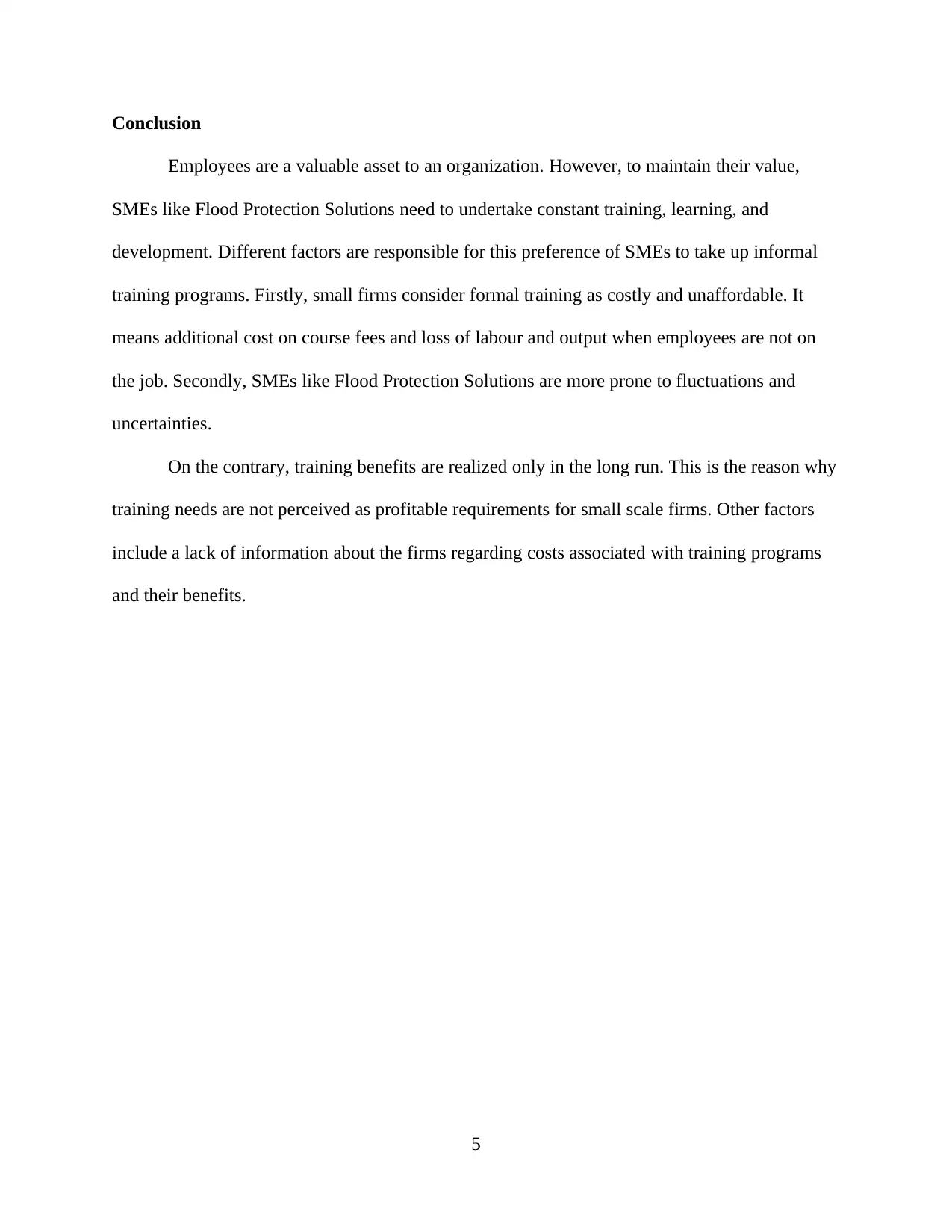
Conclusion
Employees are a valuable asset to an organization. However, to maintain their value,
SMEs like Flood Protection Solutions need to undertake constant training, learning, and
development. Different factors are responsible for this preference of SMEs to take up informal
training programs. Firstly, small firms consider formal training as costly and unaffordable. It
means additional cost on course fees and loss of labour and output when employees are not on
the job. Secondly, SMEs like Flood Protection Solutions are more prone to fluctuations and
uncertainties.
On the contrary, training benefits are realized only in the long run. This is the reason why
training needs are not perceived as profitable requirements for small scale firms. Other factors
include a lack of information about the firms regarding costs associated with training programs
and their benefits.
5
Employees are a valuable asset to an organization. However, to maintain their value,
SMEs like Flood Protection Solutions need to undertake constant training, learning, and
development. Different factors are responsible for this preference of SMEs to take up informal
training programs. Firstly, small firms consider formal training as costly and unaffordable. It
means additional cost on course fees and loss of labour and output when employees are not on
the job. Secondly, SMEs like Flood Protection Solutions are more prone to fluctuations and
uncertainties.
On the contrary, training benefits are realized only in the long run. This is the reason why
training needs are not perceived as profitable requirements for small scale firms. Other factors
include a lack of information about the firms regarding costs associated with training programs
and their benefits.
5
⊘ This is a preview!⊘
Do you want full access?
Subscribe today to unlock all pages.

Trusted by 1+ million students worldwide
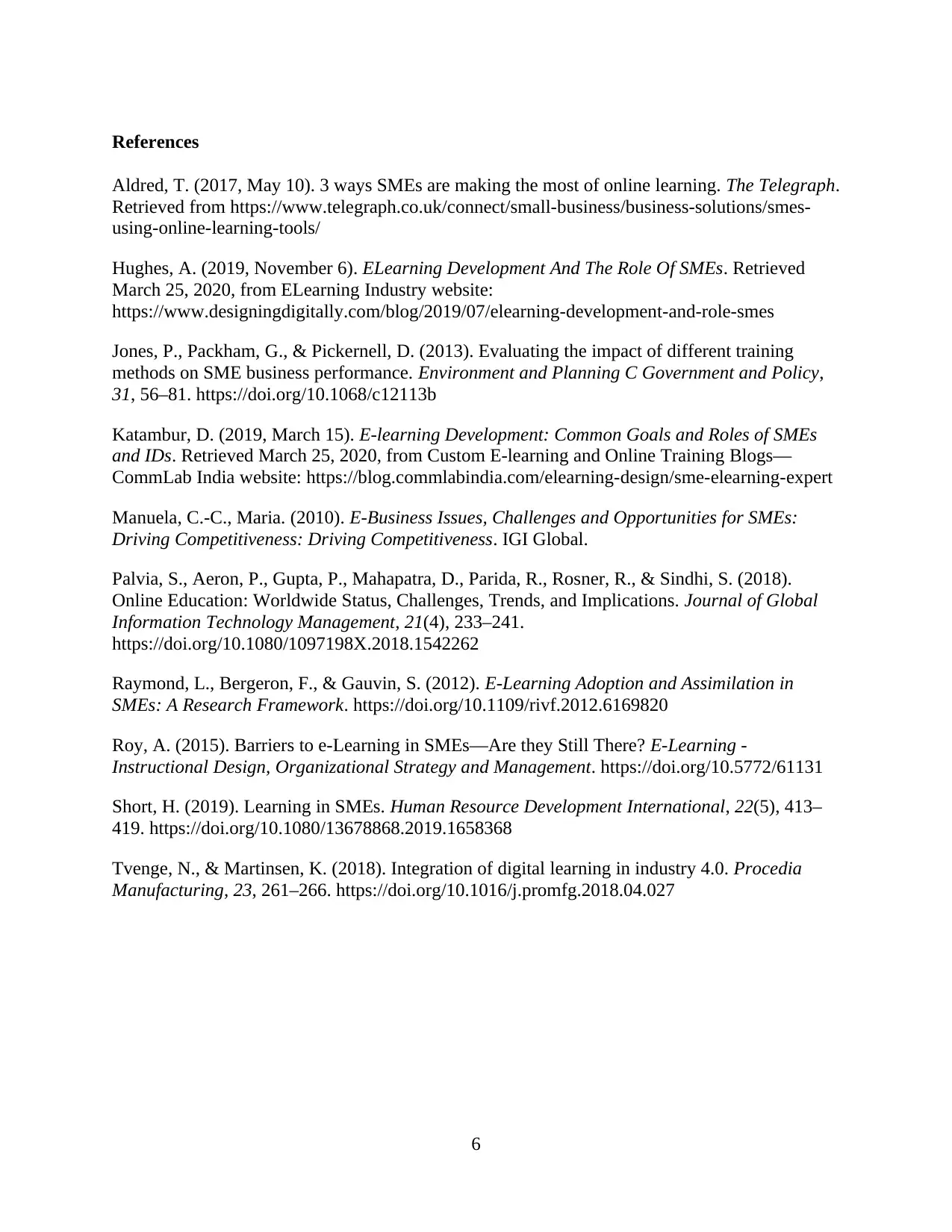
References
Aldred, T. (2017, May 10). 3 ways SMEs are making the most of online learning. The Telegraph.
Retrieved from https://www.telegraph.co.uk/connect/small-business/business-solutions/smes-
using-online-learning-tools/
Hughes, A. (2019, November 6). ELearning Development And The Role Of SMEs. Retrieved
March 25, 2020, from ELearning Industry website:
https://www.designingdigitally.com/blog/2019/07/elearning-development-and-role-smes
Jones, P., Packham, G., & Pickernell, D. (2013). Evaluating the impact of different training
methods on SME business performance. Environment and Planning C Government and Policy,
31, 56–81. https://doi.org/10.1068/c12113b
Katambur, D. (2019, March 15). E-learning Development: Common Goals and Roles of SMEs
and IDs. Retrieved March 25, 2020, from Custom E-learning and Online Training Blogs—
CommLab India website: https://blog.commlabindia.com/elearning-design/sme-elearning-expert
Manuela, C.-C., Maria. (2010). E-Business Issues, Challenges and Opportunities for SMEs:
Driving Competitiveness: Driving Competitiveness. IGI Global.
Palvia, S., Aeron, P., Gupta, P., Mahapatra, D., Parida, R., Rosner, R., & Sindhi, S. (2018).
Online Education: Worldwide Status, Challenges, Trends, and Implications. Journal of Global
Information Technology Management, 21(4), 233–241.
https://doi.org/10.1080/1097198X.2018.1542262
Raymond, L., Bergeron, F., & Gauvin, S. (2012). E-Learning Adoption and Assimilation in
SMEs: A Research Framework. https://doi.org/10.1109/rivf.2012.6169820
Roy, A. (2015). Barriers to e-Learning in SMEs—Are they Still There? E-Learning -
Instructional Design, Organizational Strategy and Management. https://doi.org/10.5772/61131
Short, H. (2019). Learning in SMEs. Human Resource Development International, 22(5), 413–
419. https://doi.org/10.1080/13678868.2019.1658368
Tvenge, N., & Martinsen, K. (2018). Integration of digital learning in industry 4.0. Procedia
Manufacturing, 23, 261–266. https://doi.org/10.1016/j.promfg.2018.04.027
6
Aldred, T. (2017, May 10). 3 ways SMEs are making the most of online learning. The Telegraph.
Retrieved from https://www.telegraph.co.uk/connect/small-business/business-solutions/smes-
using-online-learning-tools/
Hughes, A. (2019, November 6). ELearning Development And The Role Of SMEs. Retrieved
March 25, 2020, from ELearning Industry website:
https://www.designingdigitally.com/blog/2019/07/elearning-development-and-role-smes
Jones, P., Packham, G., & Pickernell, D. (2013). Evaluating the impact of different training
methods on SME business performance. Environment and Planning C Government and Policy,
31, 56–81. https://doi.org/10.1068/c12113b
Katambur, D. (2019, March 15). E-learning Development: Common Goals and Roles of SMEs
and IDs. Retrieved March 25, 2020, from Custom E-learning and Online Training Blogs—
CommLab India website: https://blog.commlabindia.com/elearning-design/sme-elearning-expert
Manuela, C.-C., Maria. (2010). E-Business Issues, Challenges and Opportunities for SMEs:
Driving Competitiveness: Driving Competitiveness. IGI Global.
Palvia, S., Aeron, P., Gupta, P., Mahapatra, D., Parida, R., Rosner, R., & Sindhi, S. (2018).
Online Education: Worldwide Status, Challenges, Trends, and Implications. Journal of Global
Information Technology Management, 21(4), 233–241.
https://doi.org/10.1080/1097198X.2018.1542262
Raymond, L., Bergeron, F., & Gauvin, S. (2012). E-Learning Adoption and Assimilation in
SMEs: A Research Framework. https://doi.org/10.1109/rivf.2012.6169820
Roy, A. (2015). Barriers to e-Learning in SMEs—Are they Still There? E-Learning -
Instructional Design, Organizational Strategy and Management. https://doi.org/10.5772/61131
Short, H. (2019). Learning in SMEs. Human Resource Development International, 22(5), 413–
419. https://doi.org/10.1080/13678868.2019.1658368
Tvenge, N., & Martinsen, K. (2018). Integration of digital learning in industry 4.0. Procedia
Manufacturing, 23, 261–266. https://doi.org/10.1016/j.promfg.2018.04.027
6
1 out of 7
Related Documents
Your All-in-One AI-Powered Toolkit for Academic Success.
+13062052269
info@desklib.com
Available 24*7 on WhatsApp / Email
![[object Object]](/_next/static/media/star-bottom.7253800d.svg)
Unlock your academic potential
Copyright © 2020–2025 A2Z Services. All Rights Reserved. Developed and managed by ZUCOL.




